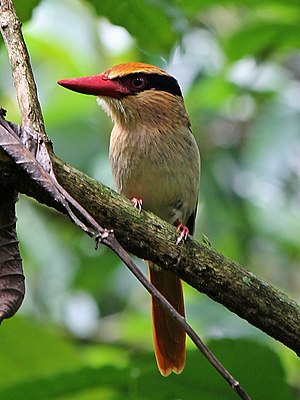Blue ear reads
| Blue ear reads | ||||||||||
|---|---|---|---|---|---|---|---|---|---|---|

Blue earliest ( Cittura cyanotis ) |
||||||||||
| Systematics | ||||||||||
|
||||||||||
| Scientific name | ||||||||||
| Cittura cyanotis | ||||||||||
| ( Temminck , 1824) |
The blue-eared lily ( Cittura cyanotis ) is a bird from the family of kingfishers found on Sulawesi .
description
Appearance
Adult blue-eared ruffles reach a length of approx. 28 centimeters. There is a very weak sexual dimorphism between the sexes . In the males, the top of the head, neck and back are brown, the control feathers reddish brown. A wide, dark blue eye mask with a whitish, very narrow stripe above the eye clearly stands out . The ear covers are colored pale purple. The throat, chest and stomach are cream-colored, the arms are dark blue. The females show similar drawing patterns as the males. They differ in the black colored eye mask and the black arm wings. The beak, iris , legs and feet are red in both sexes.
Vocalizations
The utterances of the Blauohrliest consist of a series of very fast "ku-ku-ku-ku" calls made in descending order, which are repeated at intervals of two to three seconds.
distribution and habitat
The Blauohrliest prefers to inhabit dry, wooded hilly landscapes, and sometimes also cultivated landscapes on Sulawesi. The altitude distribution extends up to 1000 meters.
Subspecies
In addition to the nominate form Cittura cyanotis cyanotis , which occurs in the north of Sulawesi, another subspecies is known:
- Cittura cyanotis modesta ( Stresemann , 1938), in the middle and southeast of Sulawesi
Way of life
The birds feed primarily on large insects, double pods (Diplopoda) and small reptiles. Little data is available due to their hidden way of life. Nests are created behind tunnels in earth walls or termite mounds . Further details on breeding behavior have yet to be researched.
Danger
The blue-eared lily is not uncommon in its distribution areas. It is therefore classified by the World Conservation Organization IUCN as ![]() “ least concern = not endangered”.
“ least concern = not endangered”.
literature
- Josep del Hoyo , Andrew Elliott, Jordi Sargatal : Handbook of the Birds of the World, Mousebirds to Hornbills. Volume 6, Lynx Edicions, 2001, ISBN 978-84-87334-30-6 .
Individual evidence
- ↑ a b c PF Woodall, GM Kirwan: Sulawesi Lilac Kingfisher (Cittura cyanotis). In: J. del Hoyo, A. Elliott, J. Sargatal, DA Christie, E. de Juana (Eds.): Handbook of the Birds of the World Alive. Lynx Edicions, Barcelona 2016. ( accessed August 25, 2016 from hbw.com )
- ^ IUCN Red List
Web links
- Blue earliest (Cittura cyanotis) in the Encyclopedia of Life . Retrieved August 11, 2017.
